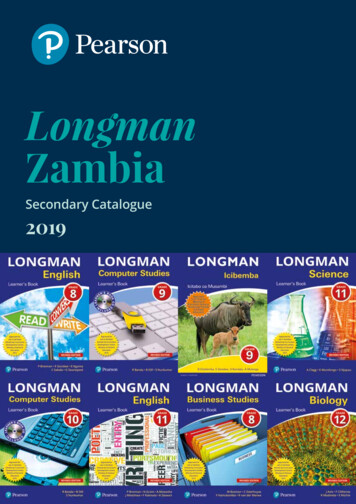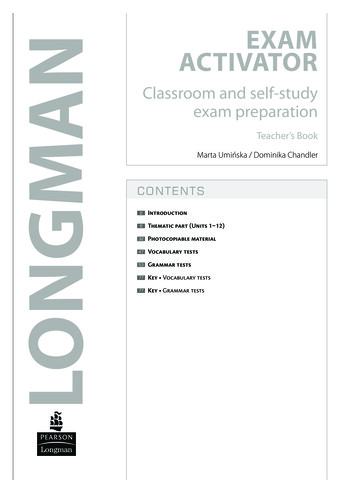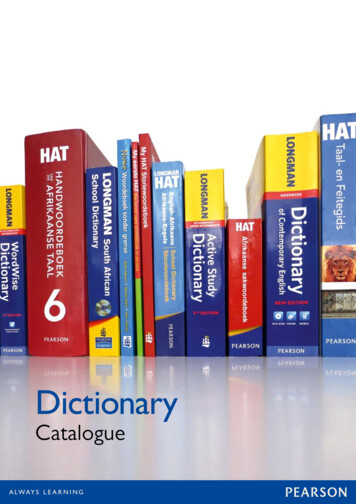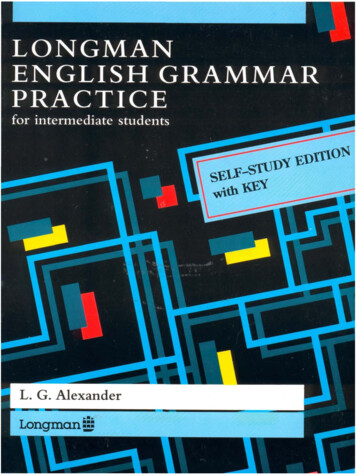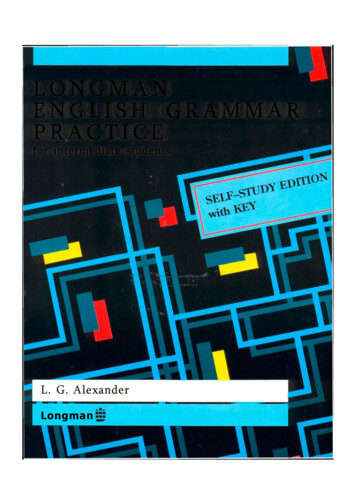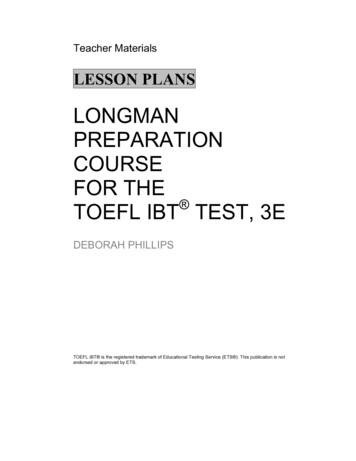
Transcription
Teacher MaterialsLESSON PLANSLONGMANPREPARATIONCOURSEFOR THE TOEFL IBT TEST, 3EDEBORAH PHILLIPSTOEFL iBT is the registered trademark of Educational Testing Service (ETS ). This publication is notendorsed or approved by ETS.
LongmanPreparationCoursefortheTOEFLiBT Test:LessonPlansCopyright sefortheTOEFLiBT thor:SarahWales- oLesson Plans Author: Sarah Wales-McGrathProject & development editor: Helen B. AmbrosioiiLESSONPLANS
CONTENTSINTRODUCTION ixHOW TO PRESENT NOTE TAKINGxviiiSECTION ONE: READING1READING DIAGNOSTIC PRE-TESTREADING OVERVIEW42VOCABULARY AND REFERENCE6SKILL 1UNDERSTAND VOCABULARY FROM CONTEXTReading Exercise 1 8SKILL 2RECOGNIZE REFERENTSReading Exercise 2 13Reading Exercise (Skills 1–2)13SENTENCES61015SKILL 3RECOGNIZE PARAPHRASESReading Exercise 3 1715SKILL 4INSERT SENTENCES INTO THE PASSAGEReading Exercise 4 22Reading Exercise (Skills 3–4)22Reading Review Exercise (Skills 1–4)23SKILL 5FIND FACTUAL INFORMATIONReading Exercise 5 281926SKILL 6IDENTIFY NEGATIVE FACTS 30Reading Exercise 6 34Reading Exercise (Skills 5–6)35Reading Review Exercise (Skills 1–6)36SKILL 7MAKE INFERENCES FROM STATED FACTS 39Reading Exercise 7 42SKILL 8INFER RHETORICAL PURPOSE QUESTIONSReading Exercise 8 47Reading Exercise (Skills 7–8)48Reading Review Exercise (Skills 1–8)4944LESSONPLANSiii
SKILL 9SELECT SUMMARY INFOMRATION 53Reading Exercise 9 54SKILL 10COMPLETE ORGANIZATIONAL (SCHEMATIC) TABLES 56Reading Exercise 10 58Reading Exercise (Skills 9–10)58Reading Review Exercise (Skills 1–10)59READING POST-TEST64SECTION TWO: LISTENING67LISTENING DIAGNOSTIC PRE-TESTLISTENING OVERVIEW 70BASIC COMPREHENSION6872SKILL 1UNDERSTAND THE GIST 72Listening Exercise 1 75SKILL 2UNDERSTAND THE DETAILSListening Exercise 2 80Listening Review Exercise (Skills 1–2)80PRAGMATIC UNDERSTANDING7783SKILL 3UNDERSTAND THE FUNCTION 83Listening Exercise 3 86SKILL 4UNDERSTAND THE SPEAKER’S STANCEListening Exercise 4 91Listening Exercise (Skills 3–4)92Listening Review Exercise (Skills 1–4)9388CONNECTING INFORMATION 96SKILL 5UNDERSTAND THE ORGANIZATION 96Listening Exercise 5 99SKILL 6UNDERSTAND RELATIONSHIPS: INFERENCES ANDDRAWING CONCLUSIONS101Listening Exercise 6 104Listening Exercise (Skills 5–6)105Listening Review Exercise (Skills 1–6)106LISTENING POST-TEST 109ivLESSONPLANS
SECTION THREE: SPEAKING 111SPEAKING DIAGNOSTIC PRE-TESTSPEAKING OVERVIEW 114112SPEAKING QUESTIONS 1 AND 2: INDEPENDENT SPEAKINGQUESTIONS 117SPEAKING QUESTION 1: FREE-CHOICE RESPONSE117SKILL 1USE YOUR NOTES TO PLAN THE FREE-CHOICERESPONSE 117Speaking Exercise 1 120SKILL 2USE YOUR PLAN TO MAKE THE FREE-CHOICERESPONSE122Speaking Exercise 2 124Speaking Review Exercise (Skills 1–2)125SPEAKING QUESTION 2: THE PAIRED-CHOICE RESPONSE127SKILL 3USE YOUR NOTES TO PLAN THE PAIRED-CHOICERESPONSE 127Speaking Exercise 3 130SKILL 4USE YOUR PLAN TO MAKE THE PAIRED-CHOICERESPONSE 132Speaking Exercise 4 134Speaking Review Exercise (Skills 3–4)134SPEAKING QUESTIONS 3 AND 4: INTEGRATED QUESTIONS (READING,LISTENING AND SPEAKING) 136SPEAKING QUESTION 3: CAMPUS-BASED INTEGRATEDREADING, LISTENING, AND SPEAKING136SKILL 5NOTE THE MAIN POINTS AS YOU READSpeaking Exercise 5 138136SKILL 6NOTE THE MAIN POINTS AS YOU LISTEN 140Speaking Exercise 6 142SKILL 7USE YOUR NOTES TO PLAN THE RESPONSESpeaking Exercise 7 147144LESSONPLANSv
SKILL 8USE YOUR PLAN TO MAKE THE RESPONSESpeaking Exercise 8 151Speaking Review Exercise (Skills 5–8)152Assignments149SPEAKING QUESTION 4: ACADEMIC SETTING INTEGRATEDREADING, LISTENING, AND SPEAKING154SKILL 9NOTE THE MAIN POINTS AS YOU READSpeaking Exercise 9 156154SKILL 10NOTE THE MAIN POINTS AS YOU LISTEN 158Speaking Exercise 10160SKILL 11USE YOUR NOTES TO PLAN THE RESPONSESpeaking Exercise 11 165162SKILL 12USE YOUR PLAN TO MAKE THE RESPONSESpeaking Exercise 12 169Speaking Review Exercise (Skills 9–12)170167SPEAKING QUESTIONS 5 AND 6:INTEGRATED QUESTIONS (LISTENING AND SPEAKING)172SPEAKING QUESTION 5:CAMPUS-BASED INTEGRATED LISTENING ANS SPEAKING172SKILL 13NOTE THE MAIN POINTS AS YOU LISTEN 172Speaking Exercise 13 174SKILL 14USE YOUR NOTES TO PLAN THE RESPONSESpeaking Exercise 14 179176SKILL 15USE YOUR PLAN TO MAKE THE RESPONSESpeaking Exercise 15 183Speaking Review Exercise (Skills 13–15) 184181SPEAKING QUESTION 6:ACADEMIC INTEGRATED LISTENING AND SPEAKING186SKILL 16NOTE THE MAIN POINTS AS YOU LISTEN 186Speaking Exercise 16188SKILL 17USE YOUR NOTES TO PLAN THE RESPONSESpeaking Exercise 17 193viLESSONPLANS190
SKILL 18USE YOUR PLAN TO MAKE THE RESPONSESpeaking Exercise 18 197Speaking Review Exercise (Skills 16–18) 198SPEAKING POST-TEST195200SECTION FOUR: WRITINGWRITING DIAGNOSTIC PRE-TESTWRITING OVERVIEW206203204WRITING QUESTION 1: INTEGRATED TASK 208SKILL 1NOTE THE MAIN POINTS AS YOU READWriting Exercise 1 210208SKILL 2NOTE THE MAIN POINTS AS YOU LISTEN 211Writing Exercise 2 213SKILL 3PLAN A POINT-BY-POINT RESPONSE USING YOURNOTES214Writing Exercise 3 217SKILL 4WRITE A POINT-BY-POINT RESPONSE USING YOURPLAN 219Writing Exercise 4 221SKILL 5USE AN ALTERNATIVE METHOD TO WRITE YOURRESPONSE 223Writing Exercise 5 225SKILL 6WRITE A TOPIC STATEMENT AND CONCLUSION 227Writing Exercise 6 229SKILL 7REVIEW SENTENCE STRUCTUREWriting Exercise 7 233SKILL 8REVIEW GRAMMARWriting Exercise 8 236Writing Review Exercise (Skills 1–8)231235237WRITING QUESTION 2: INDEPENDENT TASKSKILL 9DECODE THE ESSAY PROMPTSWriting Exercise 9 240239239LESSONPLANSvii
SKILL 10PLAN BEFORE YOU WRITE: OUTLININGWriting Exercise 10 243242SKILL 11WRITE UNIFIED SUPPORTING PARAGRAPHSWriting Exercise 11 246245SKILL 12CONNECT THE SUPPORTING PARAGRAPHSWriting Exercise 12 249248SKILL 13WRITE THE INTRODUCTION AND CONCLUSION 251Writing Exercise 13 253SKILL 14REVIEW SENTENCE STRUCTUREWriting Exercise 14 257SKILL 15REVIEW GRAMMARWriting Exercise 15 259Writing Review Exercise (Skills 9–15)WRITING POST-TESTviiiLESSONPLANS262258260255
INTRODUCTIONThe Teacher Materials books that supplement the Longman Preparation Course for theTOEFL iBT Test, Third Edition provide teachers with specific ideas and suggestions forimproving the effectiveness of their preparation courses for the TOEFL iBT test(Internet-Based Test). This Lesson Plans book is one of the books in the TeacherMaterials series.ABOUT THIS BOOKPURPOSE OF THE BOOKThe purpose of this book is to help teachers increase student-student and student-teacherinteraction in their preparation courses for the TOEFL iBT test. One of the mosteffective ways to enhance preparation for the this test is through a high degree ofinteractivity in the classroom. Students need strong communicative skills to succeed onthe test, and these skills are best strengthened by increasing the interactivity of theclassroom in every way possible.Longman Preparation Course for the TOEFL iBT Test, Lesson Plans is intendedto be used by a teacher to improve interaction and communication in a TOEFL iBT course with Longman Preparation Course for the TOEFL iBT Test, Third Edition as itsmain text. It can be used with or without the Classroom Activities book that is part of theTeacher Materials series.WHAT IS IN THE BOOKThis book provides interactive lesson plans for each of the forty-nine language skills inLongman Preparation Course for the TOEFL iBT Test, Third Edition. Each lesson planfeatures the following: A Skill Introduction section with an interactive method of introducing the skill Step-by-step instructions for setting up and reviewing the Exercises and ReviewExercises Assignments that provide optional, additional practice upon completion of a skillMATERIALS TO ACCOMPANY THE BOOKThis book is designed to accompany the texts in Longman’s Preparation Course for theTOEFL iBT Test, Third Edition. It may be used in conjunction with the completeversion of the Longman iBT program:LESSONPLANSix
Longman Preparation Course for the TOEFL iBT Test, Third Edition is a bookthat thoroughly prepares students for the Internet-based version of the TOEFLiBT test. This book covers the four sections of the TOEFL iBT test (Reading,Listening, Speaking, Writing). Website: The complete audio program to accompany this book is now included onthe text’s website at www.pearsonelt.com/TOEFLiBT and contains all of therecorded materials from the Listening, Writing, and Speaking sections as well asthe Mini-Tests and Complete Tests.Audio Transcripts: All audio transcripts are now available to download or printfrom the website at www.pearsonelt.com/TOEFLiBT. Answer Key: The answer keys are available on the website only for those whohave purchased the text with access to the answer keys. This text comes with access to the MyEnglishLab for the TOEFL iBT Test, anonline component designed to provide additional interactive practice for the test.A range of activities are provided to master the skills necessary to succeed on theTOEFL iBT test. Both skill-specific activities and authentic test-style questionsare incorporated, providing maximum exposure to the specific question typesstudents will encounter. Special features include tips for answering questiontypes, correct and incorrect answer feedback, and video presentations covering thematerial students will encounter on the test. Complete practice tests and mini-testsallow for teacher assessment and self-study assessment.This book may be used with or without the activities book that is part of the TeacherMaterials series of the Longman iBT program: Longman Preparation Course for the TOEFL iBT Test Classroom Activitiesprovides two activities for each of the forty-nine language skills in the completestudent book and the individual skills components (Reading, Listening, Speaking,Writing), for a total of ninety-eight activities.OTHER AVAILABLE MATERIALSLongman publishes a full suite of materials for TOEFL iBT test preparation. Materialsare available for the TOEFL iBT test at both intermediate and advanced levels. Pleasecontact Pearson’s website at www.pearson.com for a complete list of available TOEFLiBT test products.xLESSONPLANS
ABOUT THE TOEFL iBT TESTOVERVIEW OF THE TOEFL iBT TESTThe TOEFL iBT test is an exam to measure the English proficiency and academic skillsof nonnative speakers of English. It is required primarily by English-language collegesand universities. Additionally, institutions such as government agencies, businesses, andscholarship programs may require this test.DESCRIPTION OF THE TOEFL iBT TESTThe TOEFL iBT test currently has the following four sections: The Reading section consists of three long passages and questions about thepassages. The passages are on academic topics; they are the kind of material thatmight be found in an undergraduate university textbook. Students answerquestions about stated and unstated details, inferences, sentence restatements,sentence insertion, vocabulary, pronoun reference function, fact and negative fact,and overall organization of ideas. The Listening section consists of six long passages and questions about thepassages. The passages consist of two campus conversations and four academiclectures or discussions. The questions ask students to determine main ideas,details, function, stance, inferences, and overall organization. The Speaking section consists of six tasks, two independent tasks and fourintegrated tasks. In the two independent tasks, students must answer opinionquestions about some aspect of academic life. In the two integrated reading,listening, and speaking tasks, students must read a passage, listen to a passage,and speak about how the ideas in the two passages are related. In the twointegrated listening and speaking tasks, students must listen to long passages andthen summarize and offer opinions on the information in the passages. The Writing section consists of two tasks, one integrated task and oneindependent task. In the integrated task, students must read an academic passage,listen to an academic passage, and write about how the ideas in the two passagesare related. In the independent task, students must write a personal essay.The format of a TOEFL iBT test is outlined in the following chart:iBTAPPROXIMATETIMEREADING3 passages and 36–42 questions60 minutesLISTENING6 passages and 34 questions60 minutesSPEAKING6 tasks and 6 questions20 minutesLESSONPLANSxi
WRITING2 tasks and 2 questions60 minutesIt should be noted that at least one of the sections of the test will include extra uncountedmaterial. Educational Testing Service (ETS) includes extra material to try out material forfuture tests. If students are given a longer section, they must work hard on all of thematerials because they do not know which material counts and which material is extra.(For example, if there are four reading passages instead of three, three of the passageswill count and one of the passages will not count. It is possible that the uncountedpassage could be any of the four passages.)TO THE TEACHERWHAT TO INCLUDE IN A LESSONThe material in the Longman program is divided into individual skills that students needto master in order to succeed on the TOEFL iBT test. The teacher should make everyeffort to maximize the amount of student-student and student-teacher interaction inlessons presenting these skills. The following components of a lesson can help maximizethe interactivity of the lesson: A Warm-up Activity at the beginning of a lesson can begin the process ofencouraging student interaction and can help set the tone of the classroom as onein which interaction is to be maximized. Warm-up activities may work on generalreading, listening, speaking, or writing skills; they may review previously taughtskills; or they may serve to introduce the skill that will be taught in the lesson. The Skill Introduction section of a lesson should be as interactive as possible. Thedual purposes of interactive skill introduction are to introduce the skill in theclearest way possible and also to provide students with the opportunity to improvetheir general ability to interact with the teacher. The Exercises section of a lesson should also be as interactive as possible. Thedual purposes of interactive exercises are to provide the students with theopportunity to use the information they have learned in the skill introductionsection of the lesson and also to provide them with the opportunity to improvetheir general ability to interact with the teacher and with other students. A Follow-up Activity at the end of a lesson can provide additional studentinteraction and can also help to reinforce the idea that your classroom is one inwhich interaction is to be maximized. Follow-up activities may be activities thatreview the skill that was just taught or review a number of previously taught skillstogether; they may also work on general reading, listening, speaking, or writingskills. The Assignments that follow a lesson may also provide an opportunity for furtherinteraction. Assignments may review the skill that was just taught or review anumber of previously taught skills together; they may also work on generalreading, listening, speaking, or writing skills.xiiLESSONPLANS
HOW TO INCREASE INTERACTION IN THE TOEFL iBT TESTCLASSROOMThe teacher should make every effort to maximize the interactivity of each component ofa lesson. Consider the following suggestions for various ways to increase interactivity inyour lessons.Warm-up ActivitiesA great deal of interaction is possible in a warm-up activity. This interaction may bestudent-teacher interaction (with the teacher interacting with individual students in aclassroom setting) or student-student interaction (with students in pairs or in groups ofthree or four or more).For each warm-up activity, you should decide on the optimal kind of interaction forthe specific activity. When the purpose of a specific activity is to introduce a new skill,students may be more comfortable interacting with the teacher rather than with otherstudents. When the purpose of an activity is to review previously taught skills or toenhance general reading, listening, speaking, or writing skills, it may be more effective tohave students interact with each other in pairs or in groups.Skill IntroductionSkill introduction is a wonderful place to add interaction into lessons. Because a skill isbeing introduced and the material is new, interaction in this part of the lesson will mostlikely be between the teacher and students in the classroom as a whole rather thanbetween students. In introducing a new skill, teachers should work to develop the art ofasking leading questions; that is, teachers should try to ask questions that lead thestudents to an understanding of the new material and provide them with an approach foranswering questions that test this skill.The skill introduction questions that are provided in the lesson plans in this bookare just such leading questions. The teacher can lead the students to an understanding ofthe skill by asking an appropriate series of leading questions. After students have beenled through the introduction of the skill by the teacher, they will then be equipped with amethodology for discussing the answers to questions with other students and fordetermining the answers to questions on their own.ExercisesThe exercises provide a huge opportunity for interaction. Different kinds of interactionmay be desirable in the exercises themselves and in the review that follows the exercises.When students are completing the actual exercises, they should work on the exercisesindividually or with other students. You may want to have students work together (inpairs or in groups) on a specific exercise early on in the course as they are becomingLESSONPLANSxiii
more familiar with the skills. You may want to have students work individually on theexercises later on in the course as the date of the actual test approaches.Review of the exercises should, as a rule, include a lot of interaction. It can workwell to have the students review a particular exercise with other students before youreview the exercise with the class. To encourage student interaction as students review anexercise together, you may want to try any of the following ideas that are appropriate inyour situation: Ask students to compare their answers with other students before you give themthe correct answers. Give students clues to the answers before you give them the actual answers. (Tellthem, for example, that four of the questions in an exercise have “A” answers, butdo not tell them which questions. Have them figure out with other students whichfour questions have “A” answers.) Set up situations where students debate the merits of different answers. (Ask, forexample, which students chose answer A and which students chose answer B, andhave the students debate the merits of each answer.) Turn exercise review into a contest. (Put students into groups after an exercise, forexample, and tell the groups that there will be a contest to see which group has themost correct answers.)Follow-up ActivitiesA great deal of interaction is also possible in a follow-up activity. Since a follow-upactivity is often either a review of the skill that has just been taught or a group ofpreviously taught skills, it is often quite effective to have students interact with each otherin pairs or in groups.AssignmentsBecause assignments are generally to be completed outside of the classroom, they areoften completed individually. However, you may want to look for ways to make studentinteraction a part of assignments. Here are some ideas: Ask students to complete a particular assignment in pairs or in groups. (Instead ofasking each student to complete an exercise and turn the answers in, assign groupsto complete the exercise and submit group answers. Instead of asking each studentto write a paper and turn the paper in, assign groups to write the paper and submitgroup papers. Instead of asking individual students simply to listen to a newscastor television program, assign groups to listen to and discuss the newscast ortelevision program.) Make students responsible for other students’ assignments. (Assign students tocompare and discuss the answers to a particular exercise outside of class. Assignthe students to have a writing assignment checked by another student or otherstudents before turning it in.)xivLESSONPLANS
Make student interaction a specific assignment. (Have the actual assignment befor students to get together and talk or write. Have the actual assignment be forstudents to interact in English with non-students outside of the classroom.)HOW TO USE THE LESSON PLANS IN THE BOOKThe lesson plans can be used in different ways, depending on your teaching style and theneeds of the students in your class. The following is a possible way to use the lessonplans:Before ClassRead through the lesson plan for a particular skill. Plan a warm-up activity to begin the lesson. You may want to use the suggestedwarm-up activity in the Classroom Activities book that accompanies this series, oryou may want to use an activity of your own. Familiarize yourself with the interactive questions and answers in the SkillIntroduction section of the lesson. Decide whether you will use the questions asthey are presented in the lesson plan or whether you want to make some changesor additions to the questions. Familiarize yourself with the exercises that are part of the lesson and with theinteractive questions and answers in the Exercise section of the lesson. Decidewhether you will use the questions as they are presented in the lesson plan orwhether you want to make some changes or additions. Decide how you willorganize the exercises for maximum interactivity. Plan a follow-up activity to end the lesson. You may want to use the suggestedfollow-up activity in the Classroom Activities book that accompanies this series,or you may want to use an activity of your own. Familiarize yourself with the assignments at the end of the lesson. Decide whetheryou will use the assignments that are presented in the lesson plan or make somechanges or additions. Decide how to make the assignments as interactive aspossible.In Class Begin the lesson with the warm-up activity that you selected. Use the Skill Introduction section of the lesson to introduce the skill in aninteractive way. Complete the exercises that are part of the lesson in an interactive way. End the lesson with the follow-up activity that you selected. Give the students the assignments that you selected.LESSONPLANSxv
HOW TO INCORPORATE A LANGUAGE LOG INTO THE TOEFLiBT TEST CLASSROOMA number of the suggested assignments in this book include having students record theassignment in a language log. A language log is a notebook with a list of assignments thatstudents complete outside of class. The purpose of the language log is to emphasize tostudents the importance of working on English on their own outside of class in additionto the work they do in class. From the start of your course, you may want to have yourstudents keep a language log. The log should include the date a particular assignment isgiven, the TOEFL iBT test section the assignment relates to, a description of theassignment, and a sentence or two about the completion of the assignment. The followingis a sample page from a language log:DATESECTIONASSIGNMENTCOMPLETION OFASSIGNMENTFebruary 27SpeakingTo speak with aclassmate inEnglish for30 minutesMia and I met afterclass on Tuesday at thecoffee shop. Wediscussed a movie weboth wanted to see.February 28ReadingTo read amagazine ornewspaper articleI read a short article inthe newspapar at theschool library. Thearticle was on theproblem of risinginterest rates. Interestrates have gone up 2percent in the past year.March 1ListeningTo listen to anew program inEnglish for 10minutesI listened to the sportsreport on CNNInternational for 10minutes. The sportsreport was on theWorld Cup.March 2WritingTo write for10 minutes inEnglish on yourfavorite foodI wrote for10 minutes abouta lemon cake that mymother makes. I wrote110 words, but I thinkmy writing is not verycorrect.xviLESSONPLANS
Students should have a separate notebook that is used only for their language logand for their short writing assignments. You can check their language logs periodically tosee that students are keeping their logs up to date. (You may want to have students turn intheir logs on days that they are taking timed tests in class. Then you can check the logsbriefly while students are completing the tests.) You can also include the language log asa percentage of students’ overall grade in graded TOEFL iBT test courses.A language log can be a really effective component of a TOEFL course,demonstrating to students that they need to take responsibility for improving their Englishoutside the classroom.LESSONPLANSxvii
HOW TO PRESENT NOTE TAKINGMaterials HeadLongman Preparation Course for the TOEFL Test:iBT,3EWARM-UP ACTIVITY (OPTIONAL)Start the lesson with an activity to introduce the information in this section. You can askstudents to discuss strategies they already use to take notes. Also ask students to discussany issues they have encountered while trying to take notes.INTRODUCTIONp. xxiiThe purpose of this section ( page xxii) is to discuss the important topic of note taking.Go over the material or have students read it on their own, ask the following questions tothe class as a whole and have students answer orally. Is note taking important to success on the TOEFL iBT test? (yes, it is) When should you take notes? (when working on all the passages in the Listeningsection and on both the reading and listening passages for the integrated tasks inthe Speaking and Writing sections) Does everyone take notes in the same way? (no) So what can you learn from thissection? (some helpful tips for efficient note taking)LISTENINGp. xxiiDirect students’ attention to the explanation and example onpage xxii. Go over thematerial or have students read it on their own, ask the following questions to the class asa whole and have students answer orally. What are several ways you can organize your notes for the Listening section?(labeling the columns of a T-chart for cause and effect or for problems andsolutions, using the two columns for comparing and contrasting two differenttopics, listing advantages and disadvantages of the same topic or situation, orusing a basic outline to organize listening notes into topic, main points, andsupporting ideas) Does the student write detailed, extensive notes? (no, only enough detail toremember main examples and reasons) What did the student use to write the notes? (symbols and abbreviations)xviiiLESSONPLANS
SPEAKINGp. xxiiiDirect students’ attention to the explanation and example onpage xxiii. Go over thematerial or have students read it on their own, ask the following questions to the class asa whole and have students answer orally. How should you organize your notes for the integrated Speaking tasks? (a T-chartshould be organized so that one side lists the topic and main points of theListening lecture and the other side lists the topic and three main points of theReading passage) Does the student write detailed, extensive notes? (no, only enough detail toremember main examples and reasons) What did the student use to write the notes? (symbols and abbreviations)WRITINGpp. xxiv–xxvDirect students’ attention to the explanation and example onpage xxiv. Go over thematerial or have students read it on their own, ask the following questions to the class asa whole and have students answer orally. How should you organize your notes for the integrated Writing tasks? (a T-chartshould be organized so that one side lists the topic and main points of the Readingpassage and the other side lists the topic and three main points of the Listeninglecture) Does the student write detailed, extensive notes? (no, only enough detail toremember main examples and reasons) What did the student use to write the notes? (symbols and abbreviations)ABBREVIATIONS AND SYMBOLSpp. xiv–xvDirect students’ attention to the explanation and examples onpage xiv. Go over thematerial or have students read it on their own, ask the following questions to the class asa whole and have students answer orally. Why should you use abbreviations and symbols? (so that you can reduce the timeand the amount you write in the notes) Should you use unique and complex abbreviations and symbols? (no, usecommon or familiar symbols; write only enough to help you remember the pointsimportant to your response)LESSONPLANSxix
SECTION ONEREADING
READINGDIAGNOSTICPRE-TESTMaterials Longman Preparation Course for the TOEFL iBT TestiBT, 3ETAKING THE TESTpp. 2–5Have students turn topage 2 and show them through the test:1.Show students the directions onpage 2.2.Show students that they should read the passage onquestions.3.Show students questions 1 through 21.4.Give students 30 minutes to read the passage and complete the 20 questions thataccompany it.page 3 and then answer theCORRECTING THE TESTAfter students have taken the test, refer to the ANSWER KEY on the websitewww.pearsonelt.com/TOEFLiBTto correct the test.DIAGNOSING THE TESTp. 591After the tests are corrected, have students turn to the chart DIAGNOSING READINGERRORS onpage 591 to diagnose their errors. Have them go to the column underPRE-TEST in the chart and circle the number of each of the questions that theyanswered incorrectly or they were unsure of. Have them note which skills they need tofocus on.COUNTING THE POINTSpp. 4–5After students have diagnosed their errors, have them count their points. Ques
The Teacher Materials books that supplement the Longman Preparation Course for the TOEFL iBT Test, Third Edition provide teachers with specific ideas and suggestions for improving the effectiveness of their preparation courses for the TOEFL iBT test (Internet-Based Test). This Lesson Plans book is one o
